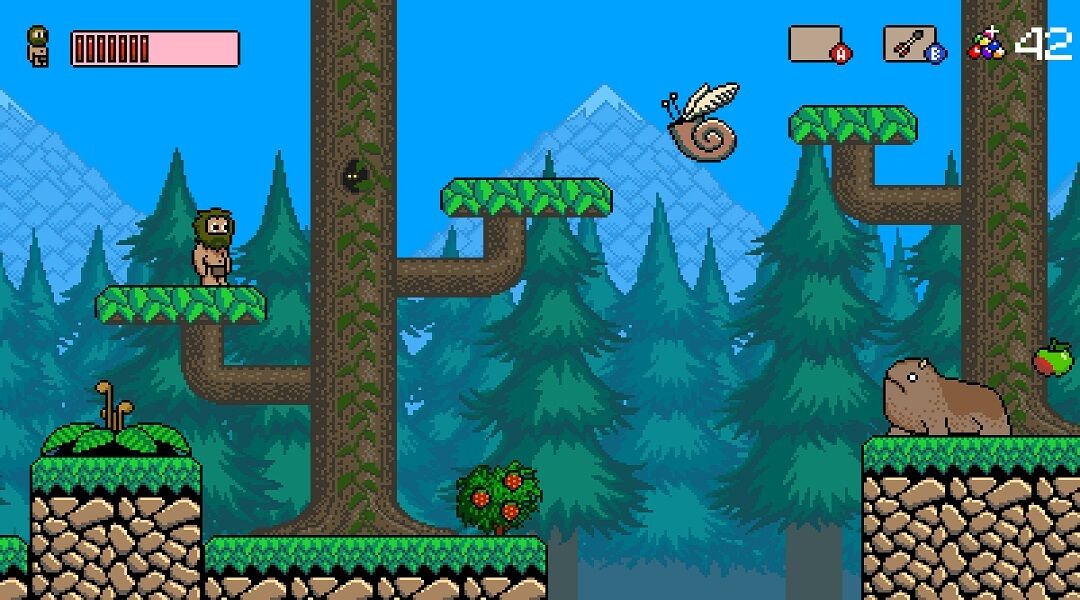Dinocide from AtomicTorch is a throwback to the NES era of gaming in more ways than just its 8-bit style graphics - it also has plenty of archaic, frustrating gameplay.
The NES-era of gaming is remembered for its 8-bit graphics, chiptune music, and blisteringly difficult games. Finding the balance between frustration and fun was the key to success in the days of the NES, and so when a developer attempts to replicate the feel of games from that era, they are faced with the same dilemma. Unfortunately for indie developer AtomicTorch, the retro throwback Dinocide is far more frustrating than it is fun.
It is not a gradual climb to the frustration either. On the contrary, Dinocide abruptly goes from being extremely easy for the first half of the game to incredibly hard in the second half, in what amounts to one of the most jarring difficulty spikes one is likely to come across in gaming.
One of the reasons why the latter half of the game is so frustrating is its inventory system. As players progress through Dinocide, they are able to collect weapons, dinosaur mounts, and gems to help them on their adventure. These items can be found in the levels, and they are added to the inventory by finishing the levels with them. Players are then able to use these items later at their leisure, but using them and dying results in the items disappearing entirely.
So, the first half of Dinocide is spent building up the inventory, as there is little to no reason to actually equip anything before going into the levels at that point in the game. Then it's possible to get through the second half without the use of the more powerful weapons or the mounts, but going without is ridiculously difficult at times.
The worst part is that in the later levels, if the inventory is depleted, players are forced to keep pushing through and hope for the best. There is no backtracking in Dinocide, which seems like an odd choice given the inventory system at play. It seems as though it would make much more sense to encourage players to backtrack to previous levels to build up their inventory in order to alleviate the difficulty of the later levels, but since that's not the case, the inventory system becomes virtually pointless in the later stages of the game.
The items that players can collect, and subsequently lose thanks to cheap deaths, range from weapons like tomahawks and boomerangs to mounts such as a fire-breathing T-Rex. There are actually a handful of different dinosaur mounts that players can obtain in the game, and while they each have little quirks that set them apart from one another (for example, the T-Rex can walk on lava, and the plesiosaurs can swim underwater), they fail at making one feel that much more powerful.
One benefit of the mounts is that they give players a second health bar. Like in the Adventure Island NES game that clearly inspired it, the main character of Dinocide has a constantly depleting health bar that must be refilled by collecting the various fruit and meat floating around the levels. Taking hits from enemies causes one's health bar to deplete at an even faster rate, so players must move quickly through the levels to obtain food, while also being cautious as to avoid running into enemies.
This starvation gameplay mechanic adds a sense of urgency to the proceedings, and without it, Dinocide would be an even lesser game. This mechanic results in some genuinely tense and exciting moments at times, and is a glimpse into how great Dinocide could have been if the developers just tweaked a few things about the game.
Sadly, those aforementioned tense moments are few and far between, and the game quickly becomes dull from the lack of those moments and due to repeating level themes. These level themes, such as desert areas, underwater levels, etc., aren't even grouped together, which makes the game feel disjointed as players randomly bounce from one theme to the next, killing any sense of meaningful progression or continuity. It doesn't help that, besides different aesthetic and enemy types, these different levels consist of largely the same unimaginative platforming mechanics at work.
The platforming monotony is rarely broken up, and the core gameplay doesn't change from start to finish. The only situations where players have any other goal besides getting from one side of the screen to the other is during boss fights, but during our time with Dinocide, we only encountered two. These encounters were easily the highlight of the experience, so only getting to experience a couple of them was disappointing to say the least.
Since the first time through Dinocide can be fairly boring with only a couple of boss battles to break up the repetition, it makes replaying the game an undesirable prospect. To AtomicTorch's credit, there are things thrown into the mix to try to add replayability, such as allowing players to pick between two levels at some points. One might think this would encourage players to go back through and see what the other path has to offer, but the levels aren't different enough from each other to justify doing so. AtomicTorch also added a dedicated speed run mode to encourage replayability as well, and while it's interesting and appreciated, it will also likely have limited appeal.
Dinocide may be a disappointment, but AtomicTorch has shown in the past that they are a capable indie developer, with their previous effort, VoidExpanse, a much better game. As we noted in our VoidExpanse review, that game was highly addictive and fun, so hopefully the third title from the young studio has more in common with that than Dinocide.
Trailer
[HTML1]
Dinocide is currently available for PC. Game Rant was provided a PC code for this review.

